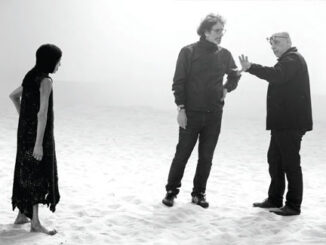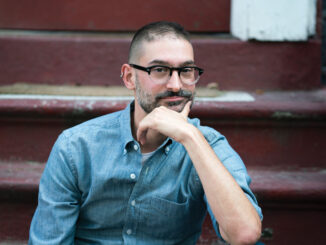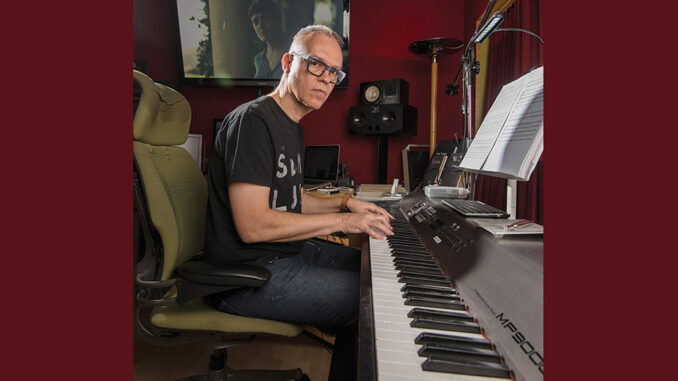
by Rob Feld • portraits by Tony Donaldson
Mikael Sandgren likes to keep busy. He straddles the worlds of indie film, studio film and television, major commercial campaigns and even video games. Born and classically trained as a composer in Sweden, where he initially found some independent work outside the government monopoly on television, he came to the US with a scholarship to the Berklee College of Music in Boston. He had experience with early nonlinear editing systems in Sweden, which he credits for his ability to quickly find sound editing work on shows like L.A. Law (1986-94) when he moved to LA.
In 1998, Sandgren began a frequent and creatively rewarding collaboration with picture editor Dody Dorn, ACE. With her, he served as music editor on Guinevere (1999), Memento (2000), Insomnia (2002), Ben-Hur (2016) and two seasons of Mike White’s series Enlightened (2011-13), with composer Mark Mothersbaugh from Devo.
From his work on Enlightened came another White project with Mothersbaugh composing, Beatriz at Dinner, which had its premiere at the Sundance Film Festival in 2017 and opened June 9 through Film Nation Entertainment and Roadside Attractions. The film stars Selma Hayek as a holistic healer on an emotional razor’s edge, a character with a close affinity to Laura Dern’s Amy Jellicoe in Enlightened, which the creators frequently referenced during production.
Hayek’s Beatriz finds herself stranded at a wealthy client’s remote home when her car breaks down, and is invited to stay for the night — a night when the client’s husband is hosting a dinner party for his boss, Doug Strutt (John Lithgow), and a colleague. The spiritually focused Beatriz is ill-equipped for the social world of her client (Chloë Sevigny), and perhaps for the world in general. As the evening progresses — and her moral outrage intensifies at Strutt’s brand of callous privilege — the film’s music must support Beatriz’s roiling emotionality without breaking…until she ultimately does.
A music editor with a lot on his plate, Sandgren is continuing his collaboration with White on Brad’s Status (again with Mothersbaugh), as well as working with the Duplass brothers (and composer Julian Wass) on HBO’s Room 104 and with composer Adam Peters on the recent Sundance documentary Icarus — all of which are due later this year. CineMontage spoke with Sandgren in April.
CineMontage: Talk about your work with Dody Dorn.
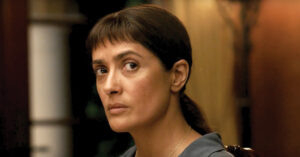
Roadside Attractions
Mikael Sandgren: Dody and I have a long, great creative relationship. She actually has a background in sound and music, so she has an inherent sense of putting music to picture. I learned a lot from her. With Guinevere and Memento, it was about not being on the nose with music but just letting it give you a feeling to help underscore something without mickey-mousing the scene too much. Just being an atmosphere or an environment that you live in while you’re taking in what’s on the screen. We see eye to eye there; that’s probably the biggest thing she taught me.
CM: How does your job differ between your studio and independent film work?
MS: A lot of times in the indie world, you work with people without a lot of experience. That can of course be chaotic, but it can also be very creatively fulfilling because you get to try a lot of things. It’s not that one type of film is better than the other. If you have a team of seasoned pros coming together and nobody feels like his or her ego is being trampled on, that’s also very nice. But the indie experience definitely has the nucleus of trying to create something for the first time, and I think that’s inspiring.
CM: Do you gravitate toward the indie world or does it find you?
MS: I’ve been drawn to it for a long time and I think it has something to do with me finding my own voice. When you first start work in LA, you’re often called to mimic things that have previously been successful. That can be really exciting and challenging: “Can I really pull this off?” But after a few years, you start questioning your creative voice: “What’s my sonic fingerprint?” I think I’ve been drawn toward things on which I could experiment with that. I’ve had some great creative relationships come out of it and those people are now working with bigger budgets.
CM: What are some projects that really enabled you to try something and find that voice for yourself? And how do you define that voice?
MS: A big one was working with Mike White and, of course, the great composer Mark Mothersbaugh, who is one of the really original voices, on Enlightened. The show’s combination of tragedy and comedy played a big part. We know Mark for somewhat whimsical music, but he can write some really heartfelt themes. I liked working with those, and even some wild stuff he wrote off-picture, and bringing them into the theme.
My aesthetic seemed to fit in with what Mike wanted and what Mark was writing, which is a small ensemble — not too many instruments playing at the same time, but instruments handing off to each other with just one or two instrumental voices playing at the same time. Especially in those vulnerable moments when Laura Dern is raging against this huge corporate monster, and then feels vulnerable and wants to give up. The sparse and heartfelt music really seems to work. And I find myself drawn to it.
CM: What about the relationships with composers and the responsibility you have with the their work?
MS: That’s something that has to be entered into with respect and a sense of service. You want to understand the composer’s aesthetic and try to service it while at the same time, of course, serving the film. The music has its own language, logic and heart that beats — and so does the film, but the film is obviously the master. You have to be very keen with following the direction of the director while guarding the composer’s aesthetic, which is why he or she was hired in the first place. They are two polarities between which you operate as a music editor.
CM: Can you differentiate your work for Chris Nolan from that for Mike White?
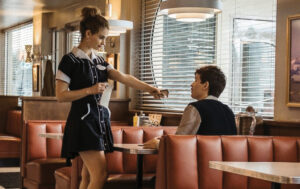
Roadside Attractions
MS: Oh, man. Obviously they’re both very specific, but Chris can articulate what he wants really well. He’s been known to sit on a plane for 10 hours listening to different musical ideas or sounds, even just to get the right sound for a character or for an event in the film. Mike is very specific also, but he jumps around. He’s almost a little neurotic in that sense, but he has a super-keen sense of what works for the film, and he’s a truly original thinker.
I can get into something where I’m so sure that it works musically and I’m so proud of what I put together, and then he points out — oh no — it doesn’t work. When he tells me why, it’s like, of course! Well, that’s what directors do. They see things from a different angle and that’s what makes this whole dance interesting and fun.
CM: What were the needs of Beatriz at Dinner? The whole film is a really delicate emotional balance, right on the edge.
MS: Mike wrote it and his longtime ally, Miguel Arteta, directed. Miguel had directed some episodes of Enlightened too, but I didn’t work with him much at that time; my main work was with Mike. They had a nickname for Beatriz — “Brown Amy” — because she was so much like Amy in Enlightened.
It was also very delicate work. We meet Beatriz, see her workday and then her experience of how we are selfishly ravaging this planet. You can’t score that with a heavy hand. The approach that we brought from Enlightened seemed appropriate for this as well. There seemed to be natural places where music should play, but I think Miguel also had to tell us to hold back and not play music in certain scenes where we otherwise might have. Just let the moment speak. And when we did score a moment, he wanted us to score Beatriz’s inner emotions, like when Strutt passes around the photograph of the rhinoceros he killed.
That was about feeling the dread as the picture is on its way to her. We haven’t seen anything yet, but we’re feeling what she’s feeling: “I don’t want to see the thing, but it’s being passed around so I’ll have to look.” Then she has her first outburst of the film. Those kinds of things are really just following Beatriz and being inside of her, speaking her voice.
CM: What’s the greatest way that you’ve seen technology change your work itself? There’s a benefit to every technological advance, but usually a detraction as well.

MS: In the end, I think it’s a benefit. The first obvious detraction is that, with all this power, you can try more things. Which means that you’re tempted to go into the work with less of a thought-through vision. Then you can get bogged down with trying out a million things when you could’ve spent more focused time trying out just a handful of ideas.
I think, on the upside, now that we work with stems and separate elements instead of cutting stereo or 5.1 masters, we can make cues bleed into each other and sometimes use elements from one cue inside of another. Sometimes by accident and sometimes by trying, we create new pieces that even the composer hadn’t thought of. I think that’s really cool, because you end up with a lot of serendipity and organic workflow.
I was doing this on a documentary called Newtown (2016), which emotionally was a very difficult project to work on. Fil Eisler was the principal composer. He called about 20 of his friends and asked them to contribute music for free, and they did. Then he asked me to put it all together. We used a voice or an instrument from one composer and combined it with the backdrop from another composer. Having that organic process happening in the background with the music, where they’d submit a track in stems that wasn’t scored to picture, would’ve been impossible to do without the technology that we have today.
CM: Does the work you’re doing for video games feel any different? Does it have a whole other process and mentality?
MS: The obvious way that video games are different is that they’re not linear and we have to anticipate a different turn of events. Oftentimes, it’s so complex that we end up writing a beginning piece, a few middle pieces and an ending piece. And by the user’s actions in the game we switch from one to the other. That works on a basic level.
There have been other attempts, like when Microsoft, in the early days, developed something called Direct Music, which created a sound engine, like a palette of instruments, that itself was created by the composer. So it wasn’t a general MIDI thing, more like a sound engine with the instruments designed by the composer. Then sequences, kind of like MIDI sequences, would play in the game and trigger this instrument palette. That was a lot of granularity. The idea was that you could trigger just a few instruments, almost like the video game was being scored on the spot by the user’s actions instead of cutting off a piece and starting up a new one. You would have pieces woven and dovetailed into each other. But it just became too ambitious and too complex to really work well.
The last video game I scored was a couple of years ago, but I think it is definitely something where the unpredictable and nonlinear approach always plays a role and is always talked about, whereas in a film or television narrative, you know how you want it to evolve over time.
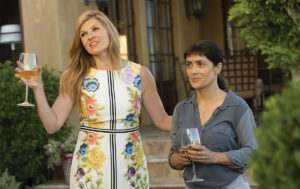
CM: Finally, there’s the practical matter of just maintaining a career and keeping work flowing into the studio. What’s good practice?
MS: The creative relationships and doing good work while being in them; and really giving everything you have and then an extra 10 percent on top of that. Also, thinking about the project, even when you’re not sitting in front of your computer, but before you go to bed or before you get out of bed or whatever. And maintaining those relationships. Then, saying “yes” to a lot; trying to take as much work as possible.
I think it’s also important to grow in my own artistic journey; to do things outside, to play music myself. I’m the choir leader for the Swedish Choir here in LA. I also do what I’d call “audio compositions” for video artist Bill Viola, who’s one of the great artists of our time. Just to do stuff that keeps me growing and changing on my own so that I don’t stagnate, because when I come back to the table with all these great people, they’ve been working on themselves as well.
That doesn’t really get you the work, but it’s definitely something that keeps you in there while you have it.




